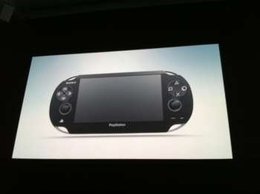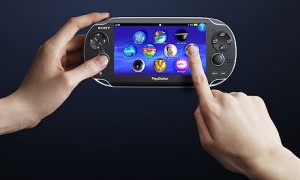After last night’s press conference where Sony announced that their new handheld will be called the NGP (Next Generation Portable) we can begin to compare the two main combatants in the next round of the handheld console war. These are two exciting devices and much of what you read here is early information, so there’s still a great deal of rumour and speculation surrounding both devices (particularly the NGP and its hardware capabilities). For the moment though, let’s take what we know and see how the two stack up against each other.
Hardware specs
NGP
 At the moment the NGP’s hardware is touted as having a “high performance CPU and GPU”. Much has been made of the unit’s ability to play PS3 quality games at comparable visual fidelity to its home console counterparts. At the show a demo was shown of Uncharted which is certainly a demanding game and something previous mobile devices couldn’t hope to run. The CPU is reported as a ARM® CortexTM-A9 core (4 core) while the GPU is a SGX543MP4+. Most impressive of all is the stunning OLED screen. At 5 inches (16:9), 960 x 544, Approx. 16 million colours, it’s a real beast of a display but makes the unit a little large as a mobile device. It also offers Bluetooth, 3G and IEEE 802.11b/g/n for some serious connectivity options. The battery life though will be a poor 4-5 hours.
At the moment the NGP’s hardware is touted as having a “high performance CPU and GPU”. Much has been made of the unit’s ability to play PS3 quality games at comparable visual fidelity to its home console counterparts. At the show a demo was shown of Uncharted which is certainly a demanding game and something previous mobile devices couldn’t hope to run. The CPU is reported as a ARM® CortexTM-A9 core (4 core) while the GPU is a SGX543MP4+. Most impressive of all is the stunning OLED screen. At 5 inches (16:9), 960 x 544, Approx. 16 million colours, it’s a real beast of a display but makes the unit a little large as a mobile device. It also offers Bluetooth, 3G and IEEE 802.11b/g/n for some serious connectivity options. The battery life though will be a poor 4-5 hours.
3DS
 The 3DS has much more conservative graphical and processing performance, but it’s no slouch. The Nintendo 3DS is based on a custom PICA200 graphics processor. Demos have shown decent but not stunning graphical performance with titles like Resident Evil and Dead or Alive showing smooth, responsive gameplay. The remake of Ocarina of Time shows significant increase in texture detail and frame rate over the original N64 version showing that the 3DS is more comparable in performance to a PS2 or even higher. It has two screens; the top screen is a 3.53 in (90 mm) 5:3 3D screen with a resolution of 800×240 pixels (400×240 pixels per eye, WQVGA) that is able to produce an autostereoscopic three-dimensional effect (one without 3D glasses), while the bottom screen is a 3.02 in (77 mm) 4:3 non-3D resistive touch panel with a resolution of 320×240 pixels (QVGA).
The 3DS has much more conservative graphical and processing performance, but it’s no slouch. The Nintendo 3DS is based on a custom PICA200 graphics processor. Demos have shown decent but not stunning graphical performance with titles like Resident Evil and Dead or Alive showing smooth, responsive gameplay. The remake of Ocarina of Time shows significant increase in texture detail and frame rate over the original N64 version showing that the 3DS is more comparable in performance to a PS2 or even higher. It has two screens; the top screen is a 3.53 in (90 mm) 5:3 3D screen with a resolution of 800×240 pixels (400×240 pixels per eye, WQVGA) that is able to produce an autostereoscopic three-dimensional effect (one without 3D glasses), while the bottom screen is a 3.02 in (77 mm) 4:3 non-3D resistive touch panel with a resolution of 320×240 pixels (QVGA).
The non glasses 3D has been widely praised from all who have tried it but requires a very strict, specific viewing angle. The 3D can be tuned down or up and when turned off completely the framerate can be doubled, representing the fact that the console no longer has to render two screens. Connectivity works with a complex, two tier street pass/spot pass system which allows you to find gamers when travelling and is an improvement on the old friend’s code system. It has no 3G support. The battery life is a stingy 3-5 hours.
Features
3DS
The 3DS has only one analogue stick (the control circle) as well as a D-pad, touch screen and other similar controls to the original DS. It has front and back facing cameras at 0.3 megapixels which can be used to take low quality photos or can be used in games. There is also an additional control to change the level of 3D effect displayed by the console.
NGP
Two words: Dual thumbsticks. As well as this, the unit features a front touch screen and a back touch panel which is the same size as the touch screen. Curiously, this allows users to “pinch” which may have some gaming applications…apparently. I can’t imagine how uncomfortable that will be to hold. There are also front and back cameras and a three axis electric compass which should allow the games to change their display based on the orientation of the device. This has been highlighted as a way to interact with Artificial Reality Games, a genre that no one has yet done anything interesting with. Overall, Sony seems to have loaded the NGP with every hardware feature it could think of.
Storage
NGP
The NGP uses “new game medium”, which is Sony’s term for some flash based media.
 “Taking advantage of the flash memory feature, this innovative card can store the full software titles plus add-on game content or the game save data directly on to the card. By adopting flash memory based card, SCE will be able to provide game cards with higher capacity, allowing developers to store more game data to deliver rich and immersive games.”
“Taking advantage of the flash memory feature, this innovative card can store the full software titles plus add-on game content or the game save data directly on to the card. By adopting flash memory based card, SCE will be able to provide game cards with higher capacity, allowing developers to store more game data to deliver rich and immersive games.”
This means the NGP will not be backwards compatible with PSP games. This is understandable as UMD’s were a mistake, but is nonetheless very sad for all those dedicated PSP fans that propped up the sales of the device. How about a PSP UMD transfer kit Sony!!
3DS
The 3DS uses flash cartridges similar to those in the original DS. It also allows the use of flash cards to save downloaded game data and purchases like the DSi. Crucially the 3DS is backwards compatible meaning it has a huge library of DS games already available. Playing these games will reduce the battery life far more slowly than the more demanding 3DS games.
Games
NGP
The list of Developers mentioned is…well, all of them. Prominently, there’s a Call of Duty game coming. Uncharted is obviously on the cards and all the usual suspects are present including Rockstar.
3DS
 While many of the same companies working on NGP games are also working on 3DS games, the device has the advantage of great first party support. Theres a reason that Nintendo dominated the last generation of handhelds, and that reason was software. Although Ocarina has been delayed (and is a 13 year old game), new releases like Kid Icarus, Star Fox and the long awaited Pilot Wings Resort are titles available on no other device. This could be key in this console battle. Will the NGP have similar, must have titles unavailable on any other platform?
While many of the same companies working on NGP games are also working on 3DS games, the device has the advantage of great first party support. Theres a reason that Nintendo dominated the last generation of handhelds, and that reason was software. Although Ocarina has been delayed (and is a 13 year old game), new releases like Kid Icarus, Star Fox and the long awaited Pilot Wings Resort are titles available on no other device. This could be key in this console battle. Will the NGP have similar, must have titles unavailable on any other platform?
Conclusion
So that’s how the two line up then. Does anyone get a distinct feeling of déjà vu? Nintendo come out with a clever use of existing technology and create an elegant, fun but technologically conservative handheld. Sony meanwhile come out with a technological behemoth that offers every feature you might imagine and more in a big-brick format. Will it be a rerun of the last time these two Japanese giants clashed?
I’m not so sure. The 3DS does not have the advantage of being competitively priced like the original DS was. If there is anything resembling parity in the prices of the two devices then it will be hard to look past the sheer power of the NGP. On the other hand, how can Sony afford to sell this new monster for anything like a reasonable price tag? The feature list is incredible and the OLED screen alone will push up the manufacturing costs significantly. Meanwhile, if the games released for the NGP will be graphically similar to those on the PS3, how will gamers justify buying two versions? If the new FIFA or Madden is near identical on PS3 and NGP, will there be some method of buying both at discount, or will you have to pay full price for both? If gamers are unwilling to do so then Sony could be doing no more than cannibalising their own software sales from one device to another.
For me, the key issues will be connectivity and price. Both devices offer online stores, but these cannot continue to offer overpriced minigames; that’s a market already cornered by Smartphones. Instead, these stores need to allow links between the home console and handheld versions of games to be purchased, moreso in the case of the NGP. The original PSP showed that a sub standard home console game on a handheld is a compromise that pleases no one. If they want the NGP to be a success, they will have to build a more innovative software library that highlights the unique features of the device or find a way to let gamers have a unified mobile and home games library without buying everything twice. If they can’t do that, they will be doomed to second place again.